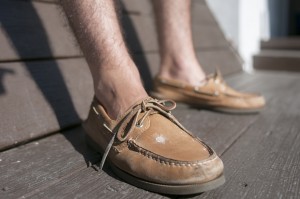I’m fascinated by any style that I can describe as a combination of Jim Carrey from “Ace Ventura: Pet Detective” and a yuppie from a John Hughes movie.
This style, often labeled as “bro” style, mixes traditionally preppy staples with more California-casual pieces. It is very prevalent on our West Coast campus, especially among the undergraduate male students.

(Jessica Zhou/Daily Bruin)
Although this style seems to be growing in popularity on campus, the look still has not been clearly defined.
This week, I’ve decided to discuss this fusion look because I acknowledge it as a part of our campus fashion scene that is as hard to define as it is to comprehend.
Fundamental elements of the style are pulled from the East Coast prep look but with more of a West Coast casual spin.
The polos, plaids and pastels that we see often on campus can be associated with the stereotypical collegiate menswear style of the East, deriving from New England preparatory schools in the early 1900s.
One article of clothing inspired by the early East Coast style is the Sperry Top-Sider shoe worn by many men and women on campus.
Sperrys, the first brand of boat shoes, were designed by Paul Sperry in 1935 and were made specifically for better grip to improve balance while yachting. Almost 80 years later, the shoes have survived both as a viable footwear option for the modern college student as well as a style symbol for East Coast recreation and sophistication.
Edward Garcia, a first-year physiological science student, said his style has shifted since moving to Los Angeles from Bakersfield in the fall and buying his first pair of Sperrys.
Garcia said that since he started attending UCLA, he’s noticed an increase in students, including himself, adapting their personal style to resemble a more preppy look.
These pieces are often associated with recreation sports, yachting and Ivy League schools. Surprisingly, this classic style of dress was adopted in a region where the modern men donning the clothing don’t typically own yachts.
On the other end of the spectrum from preppy, the style is infused with influences from surf and beach culture.
For instance, on any given day, I probably see a handful of UCLA students wearing tropical-print button-up shirts.
Although seemingly throw-on pieces that can be found at any thrift store, these shirts have a lot more significance to the fusion West Coast collegiate style than many wearers possibly consider. The patterned shirt is a piece that I consider to be an essential component of the look as it clearly marks a distinction from the rules of pure preppy style.
The Hawaiian shirt, also known as the Aloha shirt, began its mass production and distribution out of Hawaii in the 1930s. It quickly gained popularity in California, a state that was stylistically more open to casual garments.
The preppy East Coast-inspired style, paired with Southern California’s relaxed clothing, introduced a mismatched aesthetic look that defies the values of its posh originators.
The individual pieces’ conflicting origins make up an entire look that eludes a concrete definition, leading me to believe that there exists different levels and variations of dressing within this style.
This variation is similar to a scale of sorts that allows for quite a bit of range, from patterns recalling “The Fresh Prince of Bel-Air” on one side to Carlton Banks-inspired business-casual staples on the other. This college-specific style and its scale rejects the dichotomy that supposedly exists between the casual California surfer guy and preppy East Coast country club guy.
“I would definitely say that you can mix more of the preppy look with more casual pieces,” Garcia said. “Occasionally I’ll throw on a pair of (Chuck Taylors) or a normal T-shirt instead of the usual preppy look (of Sperrys and a collared shirt).”
My own feelings toward the West Coast “bro” look are as muddled as the style itself. It is difficult for me to see how two such different influences of California casual and preppy East Coast can coalesce cohesively. However, after observing how far a niche style can vary and evolve from its more preppy origins, I’ve developed a newfound admiration for this style that evades a simple definition.
How would you define West Coast “bro” style? Email Gill at ngill@media.ucla.edu.
